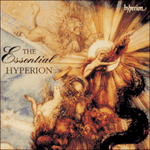The harmonically clear and very French aesthetic of Satie is nowhere better seen than in his
Trois Gymnopédies for piano, which were among his earliest published compositions. They have proved his most popular works, not only because of his friend Debussy’s orchestrations of two of them, but also through their haunting simplicity and classical restraint. We can paraphrase Lambert, who likened the aural effect of these three rather similar pieces to walking around a piece of sculpture, viewing it from various angles. Satie preferred not really to explain the rather esoteric title: it has always been assumed that the word ‘gymnopédies’ vaguely refers to the dances performed for several days without interruption by naked youths in classical Sparta. Debussy decided to orchestrate two of the three
Gymnopédies after hearing Satie play them (not particularly well) on the piano at the house of the conductor Gustave Doret in 1896. They were first performed at a Société Nationale concert on 20 February 1897. Debussy orchestrated Satie’s first and third
Gymnopédies and reversed this order upon publication. There have been many orchestrations of the
Gymnopédie missed by Debussy (No 2); that recorded here is by Ronald Corp, who uses the same orchestra as Debussy and very much continues the mood of unity and calm established by him.
from notes by Simon Wright © 1989
L’esthétique harmoniquement limpide, toute française, de Satie ne ressort nulle part mieux que dans les
Trois Gymnopédies pour piano, qui furent parmi ses toutes premières pièces publiées – parmi ses plus populaires aussi, grâce aux orchestrations que son ami Debussy fit de deux d’entre elles, mais aussi à leur simplicité lancinante et à leur retenue classique. Et nous pouvons, pour paraphraser Lambert, comparer l’effet sonore de ces trois morceaux assez similaires à une déambulation autour d’une sculpture vue sous divers angles. Satie préféra rester vague quant à leur titre plutôt ésotérique: on a toujours perçu dans le terme «gymnopédie» une lointaine référence aux danses que des jeunes gens nus exécutaient pendant plusieurs jours d’affilée dans la Sparte classique. Debussy décida d’orchestrer les première et troisième
Gymnopédies – il les inversa au moment de la publication – après avoir entendu Satie les interpréter (pas spécialement bien d’ailleurs) au piano, chez le chef d’orchestre Gustave Doret en 1896. Elles furent créées lors d’un concert de la Société Nationale, le 20 février 1897. La
Gymnopédie no2, absente chez Debussy, fut maintes fois orchestrée; la présente instrumentation, de Ronald Corp, conserve l’orchestre de Debussy, tout en préservant l’atmosphère d’unité et de calme instaurée par ce dernier.
extrait des notes rédigées par Simon Wright © 1989
Français: Hypérion
Die harmonisch klare und ausgesprochen französische Ästhetik Saties zeigt sich nirgends vorteilhafter als in seinen
Trois Gymnopédies für Klavier, die zu seinen frühesten veröffentlichten Kompositionen gehören. Sie haben sich als seine populärsten Werke erwiesen, und zwar nicht nur deshalb, weil sein Freund Debussy zwei davon orchestrierte, sondern auch wegen ihrer sehnsuchtsvollen Schlichtheit und klassischen Selbstbeschränkung. Wiederum kan man sich hier auf Lambert berufen, der die akustische Wirkung dieser drei recht ähnlichen Stücke mit dem Gang um eine Skulptur verglich, die man aus verschiedenen Blickwinkeln betrachtet. Satie zog es vor, den eher esoterischen Titel nicht wirklich zu erklären: Man ist immer davon ausgegangen, dass sich das Wort „gymnopédies“ vage auf die Tänze bezieht, die im antiken Sparta über mehrere Tage hin von nackten Knaben aufgeführt wurden. Debussy entschied sich, zwei der drei
Gymnopédies zu orchestrieren, nachdem er sie gehört hatte, als Satie sie 1896 (nicht besonders gut) im Hause des Dirigenten Gustave Doret auf dem Klavier spielte. Sie wurden am 20. Februar 1897 bei einem Konzert der Société Nationale uraufgeführt. Debussy orchestrierte Saties erste und dritte
Gymnopédie und kehrte in der Druckfassung die Abfolge um. Es hat zahlreiche Ochestrierungen der von Debussy ausgelassenen
Gymnopédie Nr. 2 gegeben; die hier eingespielte stammt von Ronald Corp, der die gleiche Orchesterbesetzung wie Debussy benutzt und weitestgehend die von ihm etablierte vereinheitlichende, ruhige Stimmung weiterführt.
aus dem Begleittext von Simon Wright © 1989
Deutsch: Anne Steeb/Bernd Müller


 The Essential Hyperion, Vol. 1
The Essential Hyperion, Vol. 1
